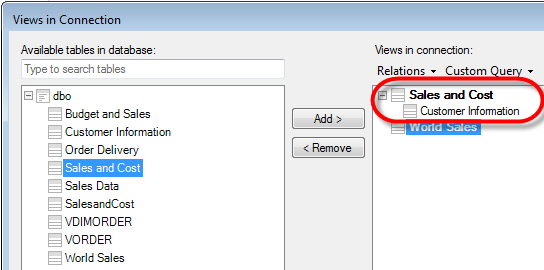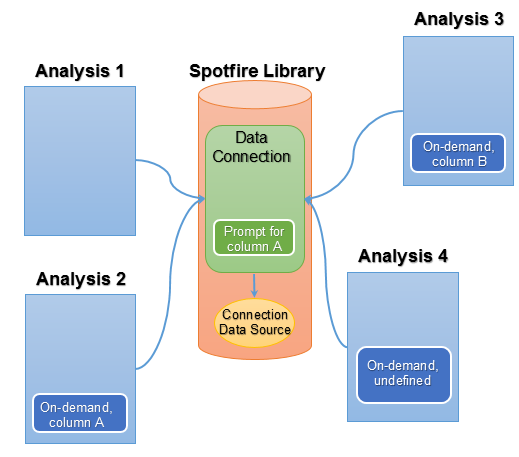

With a data connection, you can analyze data from an external system, such as a database, in Spotfire. To create and open data connections, you use the connector corresponding to the system you want to connect to. When you access data with data connections, you can either analyze data as in-database data tables, or import the data tables into the Spotfire data engine.
Data Connections and Connection Data Sources
There are two fundamental components to data connections; the data connection itself, and the connection data source.
A data connection stores information about what data in a database or cube that should be available as data tables in Spotfire. When you create a data connection, you define what data to include, and how that data should be shaped into one or more data tables.
A connection data source stores information about how a data connection should access an external system. This includes details such as server information, database name and authentication method.
The connection data source is often embedded in the data connection, and you can configure both the connection data source and the data connection when you create a new data connection.
Both the connection data source and the data connection itself can be shared in the library, if desired.
The table below describes different configuration scenarios.
Spotfire Analysis |
Data Connection |
Connection Data Source |
|
Shared in library |
Shared in library |
|
Shared in library |
Embedded in connection |
|
Embedded in analysis |
Shared in library |
|
Embedded in analysis |
Embedded in connection |
When your analyses use shared data connections you can easily update the data in a large number of analyses simultaneously by updating the data connection.
The data connections may either contain an embedded connection data source or a shared connection data source. When it comes to editing, a shared data source may temporarily be embedded in the connection, if necessary.
If your analysis contains a shared data connection you may still be able to use a cached version of the data connection if you are offline. However, this may result in inconsistencies with the expected data from the data connection on the library if the cached data is out of date.
Views in the Connection
A data connection from a cube data source always consists of a single view or data table, which combines all of the information from the selected cube, or part of the cube into one data table.
Data connections based on relational databases may contain one or more views, which may be used as data tables in the analysis. Each of the views may also be built by more than one of the source tables from the database, joined into a single view using structural relations. These relations may have been set up by the database administrator in the database but they may also be manually created in the Views in Connection dialog.

The selection of which data tables should be available in the analysis is also done in the Views in Connection dialog. In the image above, the data connection will create two views and one of those is a view combined by two related source tables. Data connections shared in the library contain a specified set of views, but data connections that are embedded in the current analysis can be edited within the context of the analysis and the currently used views in the connection can be updated. You can always embed a data connection in the Data Connection Settings dialog if you need to make any changes to the data tables in this particular analysis.
If you want to add data tables based on a view that is included in a connection already added to an analysis, you should add the data table from Files and data > Recommended option and open the data connection listed under Data connections in current analysis, rather than adding a second connection based on the same source. Because the addition of a connection to an analysis adds all views available in that connection, you already have access to all of those views in the analysis and you only need to create a new data table from it. Adding a second connection based on the same data would create another set of views and, hence, increase the impact of the analysis on the external system.
Prompting and On-demand
Prompting and on-demand loading are two ways to give the end user of an analysis the chance to select which data from a data source to analyze. See Loading Data Overview for more information. When you define prompting for a data connection you always save the prompt configuration within the data connection itself. This means that all analyses that use a prompted data connection will request the end users for input when the analysis is opened.
However, on-demand loading is defined in the analysis. If you want to configure on-demand loading for an analysis based on a prompted data connection, then you can override the prompting by defining on-demand loading for the parameter which was configured with a prompt in the data connection.

In the image above, Analysis 1 prompts for input when the analysis is opened. It has no on-demand data tables at all, so the prompting is the only limitation done.
Analysis 2 has been configured with on-demand loading of the data from the data connection, and the same parameter that was configured with a prompt has been used to define on-demand loading (for example, selection is done by marking values in another data table). This means that the prompt is overridden and the input for parameter A will come from the defined on-demand input rather than from prompting.
Analysis 3 is configured to use on-demand loading, but the on-demand loading is based on input values for column B. In this case, the analysis will prompt for input to column A, and the limitations for the on-demand data table are solely based on selection of values for column B.
Analysis 4 is configured to use on-demand loading, but no on-demand parameters have been defined. In this case, only the prompting will take effect when data is loaded.
See also: